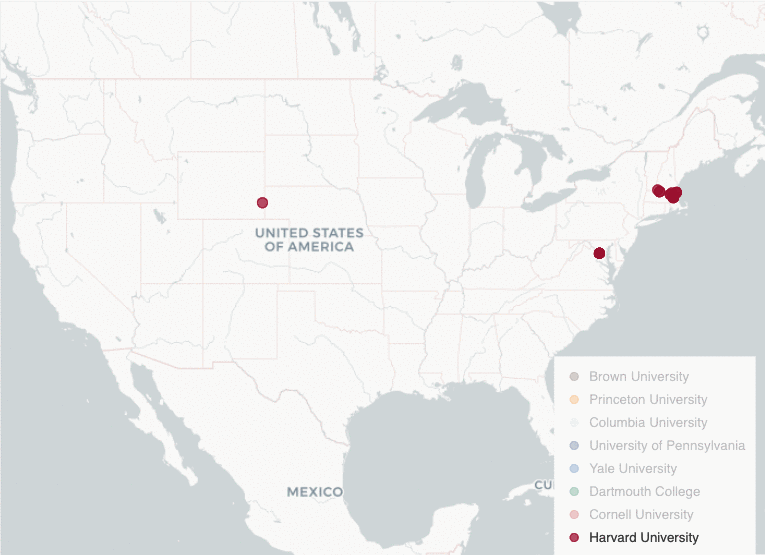Ivy league universities or real estate kings?
The net worth and impressive real estate assets of these ivy league universities prove they can be both.

When you think of real estate titans, your brain probably doesn’t immediately jump to institutions of higher learning, however, you would be remiss to not consider the extensive collection of commercial properties that are owned by Ivy League Universities.
A university is now the largest employer in two-thirds of America’s 100 largest cities, and more than a few states. Of course we think of Universities as a center for education, but with ever-rising tuition fees and continued presence in the job market, it’s harder and harder not to think of Universities as large businesses, that take on more economic and development responsibilities as their endowment grows.

We looked at the 8 powerhouses that make up the list of Ivy League Schools — Yale University, Harvard University, University of Pennsylvania, Brown University, Princeton University, Dartmouth College, Cornell University, and Columbia University to see which institution holds the most real estate assets and which has the largest endowment.
Key findings
Category | Takeaway |
|---|---|
Largest endowment | $40.9B, Harvard University |
Smallest endowment | $4.2B, Brown University |
Largest number of properties owned | 486, Cornell University |
Least number of properties owned | 48, Dartmouth College |
Highest rate of return for FY2019 | 12.4%, Brown University |
Lowest rate of return for FY2019 | 3.8%, Columbia University |
Other notable findings:
Harvard now owns more land in Allston than in Cambridge
Yale University is New Haven’s largest landlord
Yale is the largest employer in the New Haven area
Yale University owns an Apple Store
Princeton University owns over 60 acres of land in Texas
Princeton University owns roughly 160 nearby residences that can be purchased by eligible faculty and staff
The University of Pennsylvania is Philadelphia’s largest private employer
Columbia University has spent $6.3 billion on the new Manhattanville Campus expansion
Cornell University has real estate interests in 24 states and 4 foreign countries
Dartmouth College maintains a portion of the Appalachian Trail
Brown University owns an Insomnia Cookies, housed in a historic building near the school. (Insomnia Cookies was founded by a student at the University of Pennsylvania)
These Ivy League powerhouses have shown some impressive performance gains over the last fiscal year, and have proven to be true captains of real estate.
Here’s a snapshot of what we discovered for each institution, listed here in order from the largest endowment to the smallest
Harvard University
Harvard is the richest university in the world, boasting the largest endowment of all of the Ivy League universities, a whopping $40.9 billion! The institution has the largest endowment of the schools that we looked at, and it experienced a return of 6.5% during the 2019 fiscal year.
Harvard’s holdings expand beyond the Cambridge campus and the Allston expansion, though Harvard now owns more land in Allston than in Cambridge. The Harvard Business School and many of the university’s athletics facilities, including Harvard Stadium, are located on a 358-acre campus in Allston, just across the Charles River from the Cambridge campus.

Interestingly, Harvard University also boasts a few holdings in Washington DC, and land in Wyoming and New Hampshire.
The school falls in the middle of the pack in terms of the number of real estate assets, owning approximately 242 properties in a variety of asset classes. The largest percentage of which are classified as government properties.
Yale University
With a total endowment of $30.3 billion, Yale comes in a close second on our list, and it experienced a 5.7% investment return in the fiscal year ending June 30, 2019.
Yale has spent the past twenty years becoming New Haven’s largest landlord. By investing in storefronts around its New Haven campus, including a Barnes and Noble and an Apple Store, to improve the value of what had previously been a fairly low-rent area of local businesses.

Yale’s roughly 269 real estate assets are spread out among a diverse array of classes including school, commercial, open space, agriculture, multi-family, and farm.
Princeton University
Princeton University owns approximately 325 properties in a variety of asset classes like commercial, multi-family, and school, as well as several areas of vacant land. Princeton has the largest endowment per student in the U.S. Most of the properties owned by Princeton University fall in Princeton or West Windsor, one of the wealthiest neighborhoods in the U.S.

Princeton also has programs in place to partially invest in employee housing, like the Tenancy-In-Common program. Through the program, eligible faculty and staff may enter into a co-ownership agreement with Princeton to purchase residences within a nine-mile radius. In this agreement, the University pays for and owns up to one-third of the property.
Princeton also owns a few agricultural properties in Texas covering over 60 acres of land. It had a 6.2% investment return for the 2019 fiscal year, and the school’s total endowment of $26.1 billion places it 3rd on our list.
The University of Pennsylvania
The county classification of this university’s real estate assets paints them in a very diverse light in terms of property type. The institution owns around 127 properties that fall under an eclectic collection of asset classes including parking lot, hospital, research & development, office condominiums, commercial, warehouse, nursing home, utilities, and radio facility.

This diverse assortment is not surprising since Penn has a history of commercial development; the university developed many non-academic buildings in the 1990s in a project to expand throughout West Philadelphia, often in partnership with commercial developers. The university maintains land control of many of these properties, while third-party developers provide the capital. This allows Penn to provide additional assets on and around campus without depleting their resources. Plus, the university’s spending and investing in new buildings and renovations also provides thousands of jobs, which directly benefits the community. (PennToday)
The university’s total endowment of $14.7 billion makes it fourth on our list, and its average return for the 2019 fiscal year was 6.5%.
Columbia University
Columbia had the lowest return of the 2019 fiscal year, sitting at 3.8%, and its endowment is $10.95 billion.

The largest number of its roughly 220 real estate properties falls under the multi-family asset class, with the second-largest being vacant land, primarily in NYC. The university’s recent Manhattanville Campus expansion created an average of over 1,500 local construction jobs each year, for the past five years. This number is expected to climb as work on the expansion continues, generating more income and jobs for the community.
Cornell University
Cornell has the 3rd lowest rate of return for the 2019 fiscal year (5.3%) and its endowment of $7.3 billion puts it toward the bottom of the list in terms of which university has the largest net worth.
Cornell has a large urban satellite campus – the new graduate engineering school is not located in Ithaca, New York, but on Roosevelt Island in New York City, explaining the many NYC specific holdings.

Cornell showcases over 731 real estate interests, with roughly 11,000 acres in Tompkins County including the Cornell Botanic Gardens which encompasses 4,300 acres around Cornell and Ithaca. The university also owns 6,000 acres elsewhere in New York, and 2,000 acres spread out across the country.
This gives Cornell a total of 19,000 acres of land and buildings, and their real estate portfolio features assets across a vast selection of categories including residential/multi-family, vacant land, forest, farm/agriculture, orchard, hospitality/hotel, university/school, and commercial/office. Despite their overall rate of return of 5.3%, their real estate portfolio alone generated a return of 10.9%.
Dartmouth College
When it comes to properties owned, on the opposite end of the spectrum from Cornell is Dartmouth, which owns the least number of assets, about 48.
Although the number is small compared to its fellow Ivy League members, the properties are still very diverse and include a sprinkling of office, commercial, self-storage, and miscellaneous, with the largest percentage of properties falling under the school category.

Dartmouth has been involved in conservation initiatives since the 1960s and currently owns about 40,000 acres New Hampshire and Vermont. The college maintains roughly 50 miles of trails including a portion of the Appalachian Trail, and large portions of the acreage that Dartmouth owns is used for timber production, research, and educational purposes. Dartmouth’s total endowment is $5.7 billion, and it experienced a 7.5% return for the 2019 fiscal year.
Brown University
Although it holds the final place on this list, with a total endowment of $4.2 billion, Brown University actually experienced the highest rate of return for the 2019 fiscal year, 12.4%.
The university’s strong performance was spread across a diverse collection of investments, the real estate portion being roughly 51 owned properties in a wide selection of asset classes, the majority of which were commercial and multi-family.

Brown’s Commercial Real Estate Operations strives to re-use historic buildings, such as 307 Thayer Street, which was formerly used as university housing and now is home to Insomnia Cookies. The University is also involved with public-private developments like the recent South Street Landing, which promises to deliver an economic boon to the city of Providence and to the entire state of Rhode Island.
This overview of Ivy League universities’ endowments and real estate assets paints a picture of how these institutions of higher learning double as real estate giants. In their pursuit to continue their high standards of excellence, they are focused on making smart investment decisions that can help increase their endowments and build their rate of return. Real estate has definitely not been overlooked as a way to maximize returns, as evident in the number of properties owned by many of these major education organizations.
For more detailed intelligence on the commercial real estate landscape, visit our blog at Reonomy.
Author

Reonomy
Resources team
Author

Reonomy
Resources team




